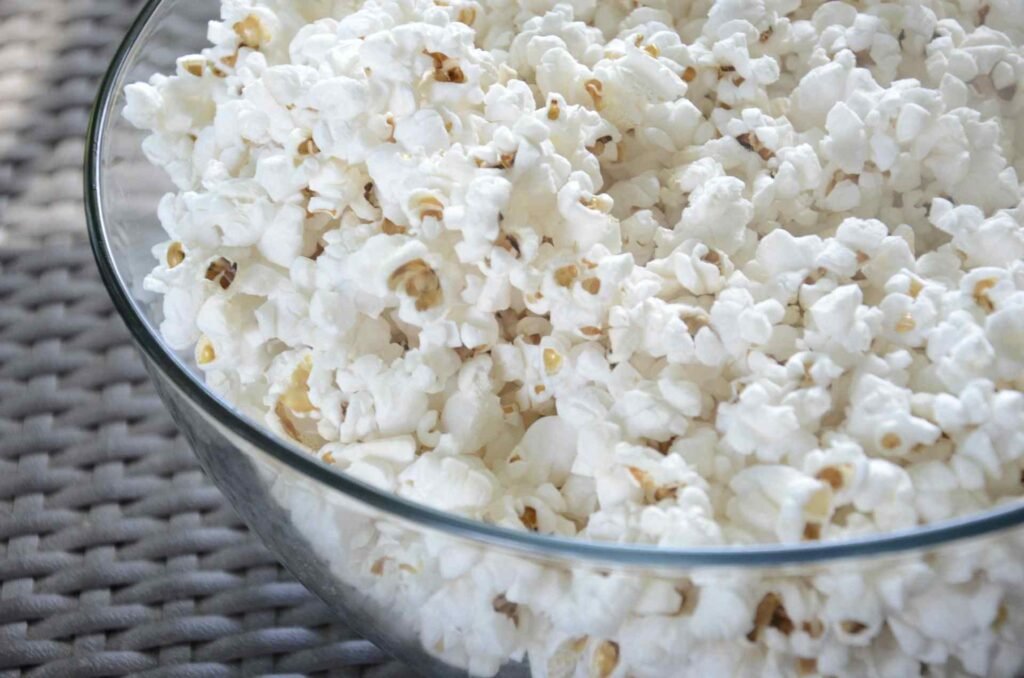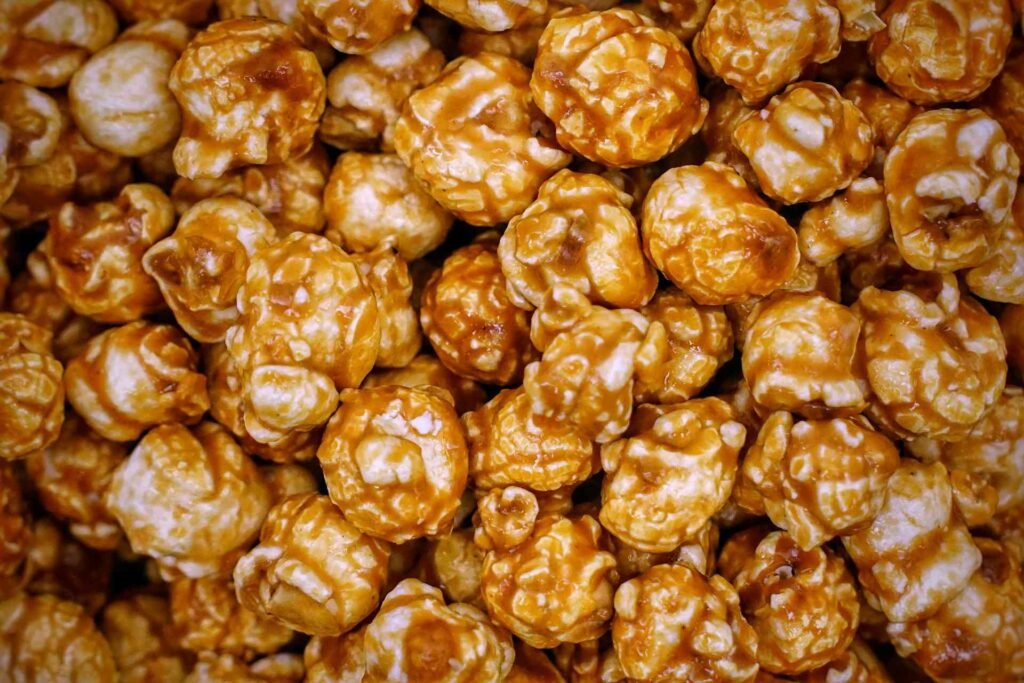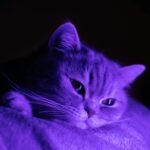Movie night just got interesting. There you are, settling in with a bowl of buttery popcorn when those familiar green eyes lock onto your snack. Your feline friend inches closer, whiskers twitching with curiosity. But before you cave to those pleading stares, you’re wondering: is popcorn bad for cats?
The short answer might surprise you. Plain, air-popped popcorn isn’t toxic to cats, but the devil’s in the details. Most of the popcorn we humans enjoy comes loaded with ingredients that can spell trouble for our whiskered companions. Understanding what makes popcorn potentially problematic for cats helps ensure your movie nights remain enjoyable for everyone involved.

What Makes Popcorn Potentially Dangerous for Cats?
While plain popcorn kernels themselves aren’t inherently toxic to felines, the way we typically prepare and season our favorite movie snack creates several concerns. Cats have vastly different dietary needs than humans, and their digestive systems weren’t designed to handle many of the additions we love on our popcorn.
The primary concerns revolve around common popcorn preparations and toppings. Most commercial popcorns contain high levels of salt, butter, oils, and artificial flavors that can disrupt a cat’s delicate digestive balance. These additions transform an otherwise neutral snack into something that could potentially cause gastrointestinal upset or worse.
The Salt Problem
When we ask “can cats eat popcorn with salt,” the answer becomes more concerning. Cats require minimal sodium in their diets, and the salt content in most flavored popcorns far exceeds their daily requirements. Excessive salt consumption can lead to sodium poisoning in cats, causing symptoms like vomiting, diarrhea, excessive thirst, and in severe cases, seizures or coma.
Commercial movie theater popcorn typically contains astronomical amounts of salt compared to what cats should consume. Even seemingly innocent microwave popcorn varieties often pack more sodium than a cat should have in several days combined.
Butter and Fat Concerns
Can cats eat popcorn with butter? This question touches on another significant issue. The high fat content in buttered popcorn can trigger pancreatitis in cats, a serious and potentially life-threatening condition. Cats metabolize fats differently than humans, and their pancreas can become inflamed when overwhelmed by sudden fatty food intake.
Butter also contains lactose, and many adult cats are lactose intolerant. This combination of high fat and lactose creates a perfect storm for digestive upset, ranging from mild stomach discomfort to severe diarrhea and vomiting.
Can Cats Eat Different Types of Popcorn?
Not all popcorn is created equal when it comes to feline safety. Let’s break down the various types and their relative risks.
Plain Air-Popped Popcorn
Plain, air-popped popcorn without any seasonings represents the safest option if you’re determined to share. However, “safe” doesn’t necessarily mean “recommended.” Even unseasoned popcorn provides little nutritional value for cats and can still pose choking hazards or cause digestive upset in sensitive felines.
The texture and size of popcorn kernels can also create dental issues for cats. Unlike humans, cats don’t chew their food thoroughly, and popcorn pieces might get stuck between teeth or cause discomfort.
Flavored Varieties
When considering whether can cats eat butter popcorn or other flavored varieties, the risks multiply significantly. Cheese-flavored popcorn combines multiple problematic ingredients: artificial flavors, high sodium content, and often dairy derivatives that can upset lactose-intolerant cats.

Sugar-coated varieties like caramel corn introduce another layer of concern. Can cats eat popcorn with sugar? Absolutely not. Cats lack the ability to taste sweetness and don’t require sugar in their diets. Excessive sugar can contribute to obesity, dental problems, and diabetes in cats.
Microwave Popcorn Dangers
Microwave popcorn deserves special mention due to its chemical additives and preservatives. Many varieties contain artificial butter flavoring, which includes compounds like diacetyl that can be harmful to both cats and humans when consumed regularly. The convenience factor of microwave popcorn often means higher concentrations of problematic ingredients.
The Choking Hazard Reality
Beyond the ingredient concerns, popcorn kernels present physical dangers to cats. Can cats eat popcorn kernels safely from a mechanical standpoint? The answer involves understanding feline anatomy and eating behaviors.
Cats have relatively small throats compared to their enthusiasm for interesting foods. Popcorn kernels can easily become lodged in a cat’s throat or cause choking. Unlike dogs, cats are less likely to chew thoroughly before swallowing, increasing the risk of airway obstruction.
Unpopped kernels pose an even greater danger. These hard pieces can damage teeth, get stuck in the digestive tract, or cause serious choking incidents. Even experienced pet owners might not recognize choking symptoms in cats quickly enough to intervene effectively.
Your Cat’s Dietary Needs
Cats are obligate carnivores, meaning their bodies are designed to derive nutrition primarily from animal tissue. Their digestive systems, taste preferences, and metabolic processes all evolved around this carnivorous lifestyle. This fundamental difference explains why many human foods, including seasoned popcorn, can cause problems.
Proper feline nutrition focuses on high-quality proteins, essential fatty acids, and specific vitamins that cats cannot produce independently. Popcorn, regardless of preparation method, provides none of these crucial nutrients while potentially introducing harmful elements.
The concept of treats in a cat’s diet should align with their nutritional requirements. Quality cat treats are formulated specifically for feline digestive systems and provide either nutritional benefits or serve specific purposes like dental health or hairball control.
Recognizing Signs of Digestive Upset
If your cat has already sampled some popcorn, knowing what symptoms to watch for becomes crucial. Digestive upset in cats can manifest in various ways, and early recognition allows for prompt intervention.
Common symptoms include vomiting, diarrhea, excessive drooling, loss of appetite, and lethargy. More severe reactions might involve difficulty breathing, excessive thirst, or behavioral changes.
The timeline for symptoms can vary significantly. Some cats might show immediate reactions within an hour of consumption, while others might not display symptoms for several hours or even the following day. Individual sensitivity levels play a major role in determining both the severity and timing of any adverse reactions.

Safe Movie Night Alternatives for Cats
Creating inclusive snack time doesn’t require sharing human food. Many commercial cat treats offer satisfying crunch and flavors specifically designed for feline taste buds. These alternatives provide the social aspect of shared snacking without the associated risks.
Freeze-dried meat treats often provide the satisfying crunch that might attract cats to popcorn in the first place. These options deliver actual nutritional value while satisfying the desire to participate in family snack time.
Some cats enjoy small pieces of cooked, unseasoned chicken or turkey as special treats. These protein-rich options align perfectly with feline dietary needs while providing variety from regular meals. Interactive feeding approaches can make treat time more engaging and mentally stimulating.
The Psychology Behind Food Sharing
Understanding why we want to share food with our cats helps address the underlying desire while making safer choices. Food sharing represents bonding and affection in human culture, and extending this to our pets feels natural and caring.
Cats, however, don’t interpret food sharing the same way humans do. They’re more interested in the attention, the change in routine, or simply the novelty of something different. Providing this positive interaction through appropriate cat treats accomplishes the same bonding goal without compromising health.
Creating engaging experiences for your cat during your own snack times can satisfy their curiosity while keeping them safely occupied. Interactive toys, puzzle feeders, or special cat treats distributed during your movie night create positive associations without dietary risks.
When Accidents Happen: Response Guidelines
Despite best intentions, cats sometimes manage to sneak tastes of forbidden foods. If your cat has consumed popcorn, particularly seasoned varieties, staying calm while taking appropriate action serves everyone’s best interests.
For small amounts of plain popcorn, monitoring for symptoms often suffices. However, if your cat consumed salted, buttered, or flavored varieties, contacting your veterinarian for guidance provides peace of mind and professional assessment of risk levels.
Keep detailed information about what type of popcorn was consumed, how much, and when. This information helps veterinary professionals determine appropriate response levels and monitoring requirements. Maintaining accurate health records supports better care in both emergency and routine situations.
Building Better Snacking Habits
Establishing clear boundaries around human food helps prevent future incidents while maintaining positive relationships with our feline companions. Consistency in these boundaries reduces confusion and helps cats understand expectations.
Training cats to respect food boundaries doesn’t require harsh methods. Simple techniques like providing appropriate distractions, using designated cat treat times, or creating physical barriers during human snack time work effectively.
Creating designated spaces for cat activities during human meal or snack times helps redirect attention constructively. Strategic placement of cat furniture can provide comfortable viewing spots where cats can observe family activities without being tempted by inappropriate foods.
Comparison Table: Human Snacks vs Cat-Safe Alternatives
| Human Snack | Risk Level | Cat-Safe Alternative | Benefits of Alternative |
|---|---|---|---|
| Buttered Popcorn | High | Freeze-dried chicken treats | High protein, appropriate texture |
| Salted Popcorn | Very High | Crunchy cat treats | Designed for feline nutrition |
| Caramel Corn | Extreme | Small training treats | Portion-controlled, cat-formulated |
| Cheese Popcorn | High | Freeze-dried fish treats | Natural flavors cats enjoy |
| Plain Popcorn | Low-Medium | Air-dried meat pieces | Actually nutritious for cats |
This comparison illustrates how every human popcorn variety has superior cat-safe alternatives that provide better nutrition and eliminate health risks.

The Economics of Pet Health
Preventing problems costs significantly less than treating them. A bag of high-quality cat treats might seem expensive compared to sharing human snacks, but veterinary bills for treating sodium poisoning, pancreatitis, or choking incidents far exceed preventive costs.
Emergency veterinary visits can easily cost hundreds or thousands of dollars, while a month’s supply of appropriate cat treats typically costs under twenty dollars. This perspective helps prioritize long-term health over short-term convenience or perceived savings.
Regular veterinary care combined with appropriate nutrition prevents many costly health issues. Investing in proper cat nutrition and avoiding problematic human foods supports both immediate wellbeing and long-term health economics.
Seasonal Considerations and Holiday Snacking
Holiday seasons often increase temptation to share special foods with pets. Halloween candy, Christmas cookies, and New Year’s party snacks all present similar risks to popcorn varieties.
Planning for holiday pet inclusion ensures cats don’t feel excluded from family celebrations while maintaining their health and safety. Many pet supply stores offer seasonal cat treats that allow participation in holiday festivities safely.
Movie marathon seasons, particularly during colder months, often correlate with increased popcorn consumption. Having appropriate cat alternatives readily available prevents spontaneous sharing decisions that might compromise feline health.
Frequently Asked Questions
Is popcorn bad for cats to eat in any amount?
Plain, air-popped popcorn in very small quantities typically won’t harm most cats, but it provides no nutritional benefits and can still pose choking risks. Any seasoned, buttered, or flavored popcorn should be avoided entirely due to high sodium, fat content, and potentially harmful additives.
Can cats eat popcorn seeds or unpopped kernels?
No, cats should never eat unpopped popcorn kernels or seeds. These hard pieces can damage teeth, cause choking, or create intestinal blockages. Unpopped kernels are particularly dangerous due to their size and hardness.
What should I do if my cat ate buttered popcorn?
Monitor your cat closely for signs of digestive upset including vomiting, diarrhea, excessive thirst, or lethargy. Contact your veterinarian if your cat consumed a significant amount or shows any concerning symptoms. The high fat and salt content in buttered popcorn can cause serious health issues.
Are there any types of popcorn that are safe for cats?
Plain, air-popped popcorn without any seasonings, butter, salt, or oils represents the least risky option, but it’s still not recommended due to choking hazards and lack of nutritional value. Cat-specific treats are always safer alternatives.
Can popcorn cause long-term health problems in cats?
Regular consumption of seasoned popcorn can contribute to obesity, kidney problems from excessive sodium, pancreatitis from high fat content, and dental issues. While occasional tiny amounts of plain popcorn are unlikely to cause lasting harm, repeated exposure to seasoned varieties can impact long-term health.
How can I include my cat in movie night without sharing popcorn?
Provide special cat treats during movie time, use interactive toys to keep your cat engaged, or offer freeze-dried meat treats that provide satisfying crunch. Creating engaging activities during family time helps cats feel included without compromising their health.
Conclusion: Keeping Movie Night Safe and Fun
While those pleading eyes might make you want to share everything with your feline friend, keeping popcorn to yourself truly shows the greatest love. Your cat won’t hold a grudge over missed popcorn opportunities, especially when you provide appropriate alternatives that actually taste good to their carnivorous palate.
Remember, cats experience flavor differently than humans. What seems like deprivation to us might actually be a relief to them. That buttery, salty popcorn that makes your mouth water could make their stomach churn. Instead, they’d probably prefer a nice piece of freeze-dried salmon or a crunchy chicken treat that speaks their culinary language.
The next time you settle in for movie night and feel those whiskers tickling your arm, reach for the cat treats instead of sharing your bowl. Your future self (and your veterinarian) will thank you for choosing prevention over potential problems. After all, the best movie nights are the ones where everyone feels good the next morning, paws and all.
Looking for more? Explore our Cat Food section for more posts like this, visit the Blog for fun and insightful reads, or browse our full Cat Category for everything feline-related, from care to comfort.
Disclaimer: This article is for informational purposes only and does not substitute for professional veterinary advice. Always consult your veterinarian for diagnosis and treatment tailored to your cat’s individual needs. Please verify current product information directly on the retailer’s site before purchasing.
Check out our most recent articles!
- Why Cats Don’t Like Closed Doors and What to Do About ItThat closed door you just shut? Your cat considers it an unwelcome barrier in their kingdom. Discover what drives this persistent behavior and learn practical strategies to create harmony between your need for privacy and your cat’s territorial nature.
- Different Types of Cat Carriers Explained: How to Choose the Right OneFrom nervous rescues to confident adventurers, every cat needs a carrier that fits their personality. Discover which type works best for your situation and how to help your cat actually accept their carrier without the usual drama.
- Funny Names for White Cats: Hilarious & Creative IdeasWhite cats deserve names as entertaining as their personalities. From sophisticated wordplay to hilariously ironic choices, discover how the right funny name transforms daily interactions with your snowy feline into endless moments of joy.
- Why Are Dogs Afraid of Thunder But Cats Aren’t (Usually)?Not all pets react the same way to thunderstorms, and there are solid biological reasons why. Understanding what makes dogs more storm-sensitive than cats helps you provide better support when severe weather strikes your area.
- DIY Halloween Costumes for Cats That Actually WorkNot all cats approach Halloween costumes the same way, which is why DIY designs win every time. From five-minute bandanas to elaborate bat wings, discover costume ideas that match your cat’s tolerance level while creating memorable moments you’ll treasure for years.
- The Best Spooky Cat Toys for This Halloween SeasonYour cat deserves to celebrate Halloween too, and the right toys make it happen. Discover why seasonal toys create more engagement than year-round options and how to choose the perfect spooky playthings for your feline’s unique personality.
- Safe Halloween Treats for Cats: Halloween Recipes and Portion GuidelinesForget the complicated recipes and store-bought novelty items. The simplest, safest, and most meaningful Halloween treats for your cat are probably already in your kitchen right now.
- Are Cats Scared of the Dark? Feline Nighttime Behavior ExplainedYour cat’s relationship with darkness is more complicated than simply “scared” or “fearless.” While cats boast impressive night vision, they can’t see in complete blackness, and what really unsettles them at night might surprise you.
- Funny Cat Halloween Costumes: From Pumpkins to VampiresHalloween costumes for cats have evolved from basic accessories to elaborate character transformations. Whether your feline embraces the vampire aesthetic or grudgingly tolerates a pumpkin hat, this guide helps you find comfortable, photo-worthy costumes that respect your cat’s boundaries while maximizing the adorable factor.
- Can You Give Cats Canned Pumpkin? Everything You Need to KnowCanned pumpkin has earned its reputation as a go-to remedy for cat digestive issues, but knowing when and how much to use makes all the difference. From understanding the fiber benefits to avoiding dangerous pumpkin pie filling, smart cat owners need the full picture before reaching for that orange can.










